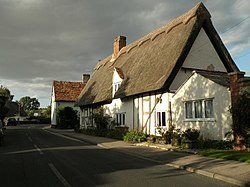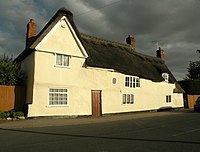Great Abington
| Great Abington | |
| Cambridgeshire | |
|---|---|
 High Street, Great Abington | |
| Location | |
| Grid reference: | TL531486 |
| Location: | 52°6’54"N, 0°14’9"E |
| Data | |
| Population: | 1,383 (2001) |
| Post town: | Cambridge |
| Postcode: | CB21 |
| Dialling code: | 01223 |
| Local Government | |
| Council: | South Cambridgeshire |
| Parliamentary constituency: |
South East Cambridgeshire |
Great Abington is a village in south-eastern Cambridgeshire, some 7 miles southeast of Cambridge. Great Abington and its neighbour Little Abington are known as The Abingtons: the two parishes are divided by the River Granta.
The name "Abington" is the Old English Æbban tun, meaning "Æbba's farm" after an otherwise unknown landowner of the Anglo-Saxon period. The manor is listed as Abintone in the Domesday Book,[1] when thre Abingtons were taken together.
History
Great Abington's parish runs down to the county border with Essex, and is bounded to the west by a branch of the Icknield Way now represented by the A11
Bronze Age traces have been found, from some 4000 years ago. The villages of Great and Little Abington were two manors on either side of the river and were allotted to different people at the Norman Conquest.
In the decades before the Second World War the Land Settlement Association created a site to the south of Great Abington consisting of over sixty houses and plots of land for unemployed miners mainly from the coalfields of Yorkshire and County Durham.[2]
The Cambridge to Haverhill railway line that opened in 1865 crossed Great Abington just south of the village, but closed in 1967. The mediæval Cambridge to Colchester road that was the main route through the village was by-passed in the 1960s.[2]
Parish church
Great Abington's parish church has been dedicated to St Mary since at least the 16th century and comprises a chancel, nave with south aisle and porch, and west tower. The majority of the present building dates from the 13th century, possibly earlier, including the two-storey tower with short leaded spire.
Village life
The village has a vibrant community with a primary school, village shop, pub, football and cricket team and a large number of local businesses, most of them at Granta Park including The Welding Institute which started in Abington Hall in 1946. In 2009 Abington Cricket Club played a friendly against Babraham Cricket Club to commemorate 150 years of the cricket team.
The remaining public house, The Three Tuns in Great Abington, is a 17th-century building that was possibly open in 1687 and certainly by 1756. Former pubs in Little Abington include The Crown which closed in the late 20th century, and The Bricklayers' Arms, which opened in the mid-19th century and was sold in 1912. The Princess (later Prince) of Wales in Great Abington opened at the end of the 19th century and closed in about 1963. The King's Arms opened on the Stump Cross to Newmarket road (now the A11) just north of Bourn Bridge in the late 17th century, closing in 1850 with the advent of the railway. The antiquary William Cole was born there while his father was publican. The White Hart opened on the same road just south of the bridge in around 1750, but closed by the end of the century.
Outside links
| ("Wikimedia Commons" has material about Great Abington) |
